Women's Roman Style Sandals: History and Trends

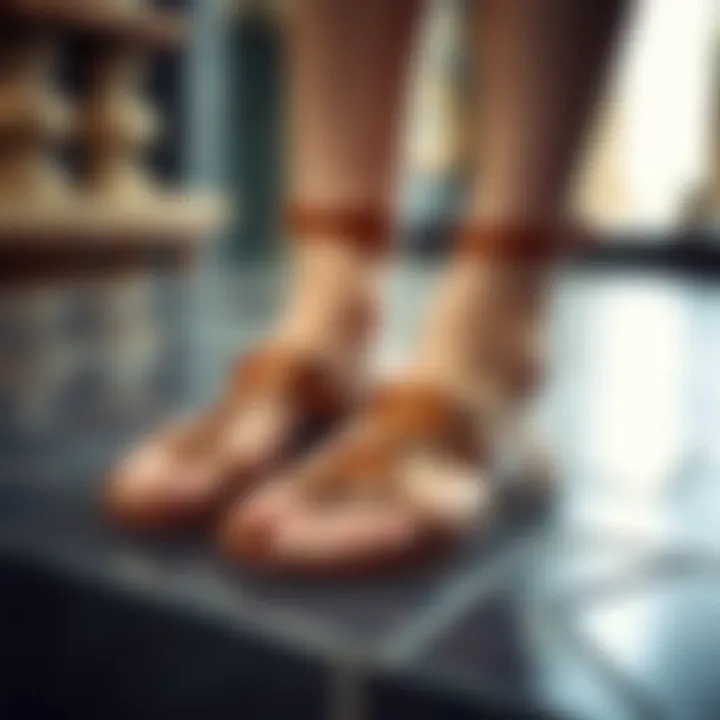
Intro
The silhouette of Roman style sandals, with their strappy design and airy construction, echoes a rich history intertwined with fashion and function. Originating from ancient civilizations, these sandals mirror the evolution of women's style through the ages. As the tides of fashion continue to rise and fall, Roman sandals have firmly planted their roots in contemporary wardrobes, resonating with both style enthusiasts and professionals alike.
Understanding women’s Roman style sandals today requires more than just a glance at their aesthetic appeal. It involves an exploration of their historical significance, the materials used in their creation, and how these designs have morphed over the years.
In diving deep into the fabric of this footwear category, we reveal how these sandals harmonize cultural influences, provide practical elegance, and offer styling versatility that transcends seasonal trends. Whether you’re a seasoned stylist seeking fresh ideas or a newcomer navigating today’s fashion landscape, this guide aims to unravel the nuances and implications of choosing to wear Roman sandals in the modern era.
Historical Context of Roman Style Sandals
When diving deep into the world of women’s Roman style sandals, it's essential to grasp their historical context. This segment sets the stage for understanding not just the evolution of the design but also its lasting impact on contemporary fashion. The blend of practicality and elegance inherent in Roman sandals illustrates their journey from footgear of the ancients to style staples today. Exploring their roots helps us appreciate the intricacies involved in crafting these sandals, their relationship with culture, and how they’ve transformed through eras.
Origins in Ancient Rome
Roman sandals trace their lineage back to Ancient Rome, a civilization renowned for its engineering marvels and extraordinary art. The original sandals, often crafted from durable materials like leather, were designed for both functionality and comfort. Workers and citizens utilized them in daily life, a testament to their practical design. Traditionally, these sandals featured an open-toe structure with straps securing them to the foot, reflecting a balance between utility and breathability.
Across the Roman Empire, these sandals were necessary, especially in warmer climates. Women, adorned in flowing togas and fitted garments, wore Roman sandals, showcasing both status and style. This is where the term “Roman style” truly began to take root, intertwining luxury with common use.
Cultural Significance
Moving beyond mere fashion, Roman sandals carry immense cultural significance. They symbolize the values of ancient Roman society—functionality paired with elegance. The sandals were not just utilitarian but also represented social status. Wealthier women often adorned their footwear with embellishments—be it beads, jewels, or intricate designs—turning these sandals into fashion statements rather than mere products of necessity.
Historians often reflect upon how Roman sandals signify the broader cultural exchanges of the times. As the Roman Empire expanded, so did the styles and designs of these sandals. Regions influenced by Roman culture began adapting these designs to suit local tastes and materials, leading to a fusion that enriched foot fashion across various cultures.
Evolution Through History
As centuries rolled on and different styles came and went, Roman sandals remained a constant staple for footwear. The fall of the Roman Empire did not diminish their appeal. Instead, they evolved, finding a place in various fashion movements. The Middle Ages saw them transform tremendously, often hidden beneath flowing garments, while the Renaissance awoke them again with fresh designs and materials.
In the 20th century, with rising trends toward retro styles, Roman sandals experienced a renaissance of their own. Designers reinterpreted classic styles with modern materials, making them accessible to a broader audience. This evolution continues today, where various interpretations of Roman sandals appear in collections by numerous brands, from high-end designers to local artisans.
"Understanding the historical context of Roman sandals not only enriches one's style choices but reveals the lasting relevance of this ancient design in today’s fashion landscape."
As we move forward in this exploration of Roman style sandals, the historical roots provide a solid foundation, illustrating their journey through time and culture, ultimately leading us to appreciate their place in modern fashion.
Design Variations of Roman Sandals
The design of Roman sandals showcases a myriad of styles, reflecting both ancient heritage and modern sensibilities. Understanding these variations is crucial for anyone interested in fashion, as each design element carries its unique implications for aesthetics, function, and cultural significance. The variations not only cater to artistic preferences but also address practical considerations in comfort and usability.
Strap Configurations
Strap configurations applied to Roman sandals can vary wildly, and each arrangement serves a purpose beyond mere decoration. They define the sandal's overall look and feel. Some designs feature minimalistic straps, allowing the foot to breathe and ensuring easy movement. This simplicity often evokes the essence of ancient Rome itself, where functionality was paramount. On the other hand, more elaborate patterns intertwine across the foot, offering a blend of style and support. These configurations often include:
- Thongs, which provide a timeless look and ease of wear.
- Crisscross patterns for extra security during long walks.
- Ankle straps that add a sophisticated touch.
These versatile configurations cater to varying tastes, ensuring there's something for everyone in the world of Roman sandals.
Heel Heights and Styles
Heel heights in Roman sandals is another critical design element that speaks to both comfort and adaptability. Low, flat sandals may reflect the practicality once favored by ancient Romans while providing a laid-back feel suitable for everyday wear. Conversely, heels—though not traditionally Roman—have found their way into modern adaptations, adding variety and elegance to the classic look.
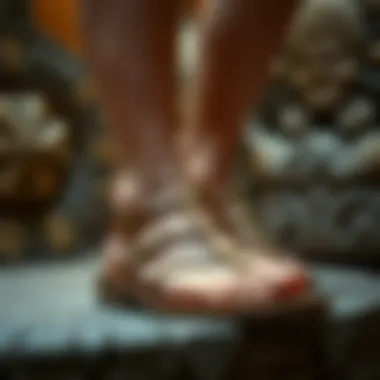
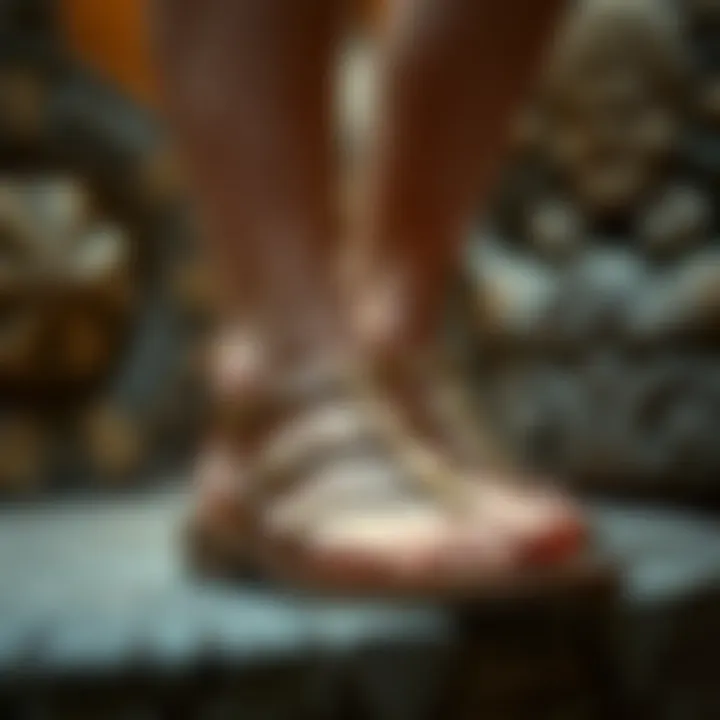
- Flat sandals: Comfort comes first, providing ease for those who are always on their feet.
- Low wedges: These offer a hint of elevation while maintaining balance.
- Block heels: A more contemporary take that provides stability and style.
Choosing the appropriate heel height largely depends on the occasion and personal preference, impacting overall confidence and comfort as one struts through the day.
Material Choices
Materials used in crafting Roman sandals are significant, as they not only determine durability but also influence the sandal's aesthetic appeal. The choice of material can affect breathability, comfort, and even style longevity. Each type offers specific advantages:
Leather
Leather has long been prized in footwear design, and for good reason. Its durability and natural breathability make it an excellent choice, ensuring sandals can withstand daily wear while still looking stylish. The key characteristic of leather is its capacity to mold to the foot’s shape over time, offering a personalized fit. Though it may require some maintenance to keep it looking its best, the longevity and undying appeal of leather make it a favored option among many fashion enthusiasts. The unique feature of leather is its aging process; it develops a unique patina, adding character and sophistication that synthetic materials simply cannot replicate.
Suede
Suede, a softer alternative to traditional leather, provides a different feel and aesthetic. Its key characteristic lies in its plush texture, offering a more luxurious touch that is pleasant against the skin. However, suede also comes with its share of challenges, notably its susceptibility to stains and water, which may hinder its practicality. What stands out about suede is its ability to elevate casual outfits into something chic, adding a layer of refinement.
Textiles
Textiles — often overlooked — can introduce color and patterns that add flair to Roman sandals. They are versatile and can be designed in countless ways, making them appealing to a younger demographic. A notable advantage of textile materials is their lightweight nature, providing comfort and coolness on hot days. However, textiles might lack the robustness of leather or suede, potentially affecting durability. Still, they offer an array of styles and colors, making them a popular choice among those who love to express their individuality through fashion.
Contemporary Relevance
The discussion around women’s Roman style sandals isn’t merely rooted in history or aesthetic appeal; it’s profoundly intertwined with modern fashion and ethical considerations. These sandals have evolved into a staple for many wardrobes, offering versatility and a nod to classic styling that resonates with today's fashion-forward thinking. The relevance of Roman sandals touches upon several critical aspects, including trends within high fashion and the increasing demand for sustainable practices in the footwear industry.
Modern Fashion Trends
Influence of High Fashion
In the realm of high fashion, Roman style sandals have reclaimed their place, strutting down runways and gracing the pages of glossy magazines. The specific aspect worth noting is how luxury designers have rejuvenated these timeless pieces by fusing traditional designs with contemporary flair. This influences not just what is seen on the runway but trickles down to retail, allowing everyday consumers to adopt high fashion elements.
One key characteristic of this influence is the introduction of upscale materials, such as exotic leathers or adorned embellishments, which elevate a simple sandal into a piece of art. These sandals are not just footwear; they are fashion statements. The unique feature here is how designers reinterpret classic Roman designs, creating something that feels both nostalgic and fresh at the same time.
Of course, high fashion can often be a double-edged sword. While it invites creativity and diversity in sandal design, it may also lead to accessibility issues for many consumers, as prices for high-end versions can escalate steeply.
Everyday Wear Adaptations
On the flip side, there's a significant adaptation of Roman sandals for everyday wear, highlighting their versatility in different contexts. The essential focus here is how brands are gearing these sandals towards comfort while maintaining stylistic integrity. People are now incorporating them into daily outfits, from casual excursions to office wear, making them a pragmatic choice for a wide audience.
A crucial characteristic is their adaptability; a simple pair of leather Roman sandals can transition seamlessly from a morning coffee run to an evening beach outing. The ability to pair them with a variety of styles—from flowy dresses to tailored trousers—reinforces their position as staple pieces in many wardrobes. However, while they provide a chic option for day-to-day wear, not all adaptations may uphold the durability expected of traditional craftsmanship.
Sustainability in Production
Eco-Friendly Materials
With increasing awareness about environmental impacts, the choice of materials in the production of Roman sandals has gained prominence. Eco-friendly materials, specifically, have seen a rise in popularity. The main highlighting factor here is the shift towards organic, recycled, or sustainably sourced materials, allowing manufacturers to meet market demands while minimizing their ecological footprint.
Using such materials not only conserves natural resources but also resonates with consumers who are more eco-conscious than ever. A unique feature of eco-friendly elements is their ability to offer durability without harming the environment. For instance, innovative fibers and upcycled textiles can create sandals that are both stylish and sustainable. The challenge, however, often lies in balancing costs, as sustainably sourced materials may be pricier, impacting retail prices.
Ethical Manufacturing Practices
Finally, the focus on ethical manufacturing practices has secured a priority place in today’s market. Ensuring fair labor practices and responsibly sourced materials reflects a broader trend toward corporate social responsibility. The emphasis on ethical practices is both an appeal to consumers seeking transparency and a way for brands to set themselves apart in a crowded marketplace.
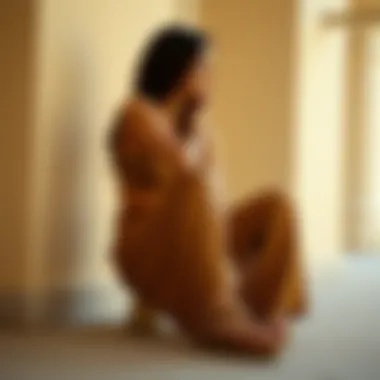

A telling characteristic of this movement is how many companies are openly discussing their supply chain and labor conditions, leading to greater consumer trust. However, the challenge lies in the complexity of ensuring that every part of the process is ethical, which can sometimes lead to compromises in cost or efficiency.
By focusing on both eco-friendly materials and ethical practices, designers are paving the way for a future that aligns with consumer values and sustainability goals.
In summary, the contemporary relevance of women’s Roman sandals reflects a marriage of tradition with modernity, not just in style but also in the ethical and sustainable context. For stylists, designers, and consumers alike, understanding these dynamics is crucial, as they shape the landscape of fashion choices available today.
Styling Roman Sandals
Styling Roman sandals is not just about slipping on a pair of shoes. It embodies a creative expression that fuses ancient aesthetic with contemporary fashion sensibilities. The Roman sandal, with its delicate straps and classic heel, contributes significantly to a wardrobe, seamlessly transitioning between casual outings and more formal events. Understanding how to style these sandals can enhance an outfit's allure and functionality, making it a key consideration for both stylists and fashion enthusiasts alike.
The myriad options in casual outfits, formal attire, and seasonal considerations present opportunities to explore different looks that suit various occasions. Let's delve deeper into combining aesthetics and comfort through appropriate styling choices.
Casual Outfits
Casual outfits with Roman sandals can offer a laid-back yet chic vibe. Imagine pairing a simple cotton sundress with strappy Roman sandals, the perfect combination for a picnic at the park. This look emphasizes comfort without sacrificing style. A well-fitted pair of linen pants worn with a loosely tucked-in tank top would create a fresh coastal vibe. For a more bohemian aesthetic, consider flowing maxi skirts that flow effortlessly with the breeze—there’s something undeniably effortless about that.
Textures play a crucial role when styling for a casual look. Opt for soft, breathable materials that promote comfort, particularly during warmer months. In essence, casual Roman sandal styling celebrates relaxed elegance and promotes ease of movement, aligning perfectly with the lifestyle of today’s dynamic woman.
Formal Attire
When the occasion calls for a touch of class, Roman sandals can be styled to fit formal attire as well. Pairing high-waisted trousers and a tailored blouse with minimalistic Roman sandals creates a sophisticated look that breaks away from traditional heels. Opting for metallic straps or embellished designs can add a hint of glamour to the ensemble without overwhelming it. These small details are what make Roman sandals an intriguing option for semi-formal gatherings and even some formal events.
The key characteristic in styling Roman sandals for formal events is to maintain a balance between elegance and comfort. Choosing darker colors or subtly patterned materials can elevate the overall appearance while the sandals support one’s posture. Overall, formal outfit styling transforms the Roman sandal into a versatile accessory that adds unexpected sophistication.
Seasonal Considerations
Summer Styles
Summer is undoubtedly the prime time for Roman sandals to shine. They are breathable and keep the feet cool when temperatures escalate. Styling for summer means embracing brightness and lightness. A floral-printed dress paired with soft, nude Roman sandals presents a lovely summer ensemble that highlights one’s legs and offers a touch of whimsical charm. The sandals' open design allows for maximum airflow, making them not only stylish but also practical for heat.
The unique feature of summer styles is their commitment to comfort without sacrificing beauty. On the flip side, one must consider the sandals' durability when exposed to harsher elements, as the sun and sand can wear down materials. However, selecting robust designs can fend off early wear and tear, ensuring that these sandals remain a favorite season after season.
Transitional Wear
As the seasons shift, Roman sandals can also be used effectively for transitional wear. This aspect speaks to versatility, allowing styling from warm to cooler climates. Mixing summer dresses with light cardigans can be an effective styling choice that uses Roman sandals as a bridging piece. For instance, pairing a denim skirt with a fitted long-sleeve tee and Roman sandals can provide a comfortable balance during transitional days.
The elegance of transitional wear lies in layering; it creates a polished look that can adapt to changing temperatures. As with summer styles, it’s essential to choose materials that allow the foot to breathe but provide enough coverage against cooler air. Overall, transitional wear styling expands the possibilities, demonstrating how Roman sandals can serve as a staple regardless of weather changes.
Practical Considerations
When it comes to women's Roman style sandals, a thorough understanding of practical considerations can greatly impact the decision-making process for both consumers and those involved in the fashion industry. Comfort, durability, and foot health implications are key areas to focus on. Balancing aesthetics with usability is crucial. This ensures not just style but also functionality, making a world of difference in how these sandals are perceived and utilized.
Comfort and Fit
The comfort of a sandal is paramount, especially for those who plan to be on their feet for extended periods. Ensuring the right fit involves a few key elements. First off, the width and arch support matter a lot. A poorly fitting sandal can lead to discomfort and even foot pain. Roman sandals often come in various widths, which caters to different foot shapes. Just as important is the cushioning on the soles—this can make or break that all-important comfort.
- Try before you buy: Walking around in the sandals for a few moments can help determine if they are a good fit.
- Footbed technology: More brands are incorporating contoured footbeds that provide additional support.
So you see, taking the time to find the perfect fitting Roman sandal can ensure long-term satisfaction and wearability.
Durability and Maintenance

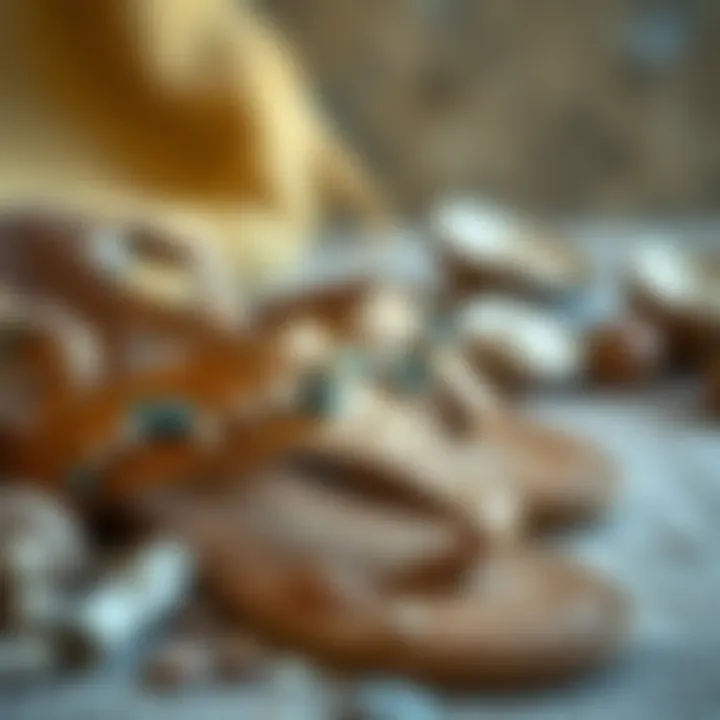
Durability isn't something to be taken lightly when choosing a pair of Roman sandals. Given their often minimalistic design, you might think they lack sturdiness, but that’s far from the truth. Quality materials, such as full-grain leather or thick suede, can withstand daily wear and tear. However, maintenance is crucial to prolong the life of these sandals.
- Care routine: Regular cleaning with a damp cloth can keep the material looking fresh. Leather may benefit from occasional conditioning, while suede often requires specific brushes to maintain its texture.
- Avoiding harsh environments: Exposure to extreme weather—be it too much sun or rain—can damage the sandals.
Keeping these points in mind will not only increase the lifespan of the footwear but also maintain its aesthetic appeal.
Foot Health Implications
Finally, the impact of footwear on foot health is significant. Roman sandals, with their typically open design, can promote better airflow, which is crucial on hot days. However, it’s vital to remember that not all sandals are created equal in this regard.
- Inadequate support: Wearing flat sandals without arch support can lead to issues like plantar fasciitis or even bunions over time.
- Sole thickness: A good pair of sandals should have soles thick enough to protect your feet from rough surfaces, yet flexible to allow for natural foot movement.
Understanding these practical aspects of Roman sandals can empower consumers to make informed decisions, ensuring they not only look good but feel good, too. After all, stylish footwear is only worth it if it's comfortable and sustainable.
Market Trends and Consumer Preferences
Understanding market trends and consumer preferences is essential for anyone involved in the fashion industry. Roman style sandals, particularly those designed for women, have carved out a unique niche that intertwines historical significance with modern trends. Examining these factors offers key insights into not only design evolution but also consumer behavior, preferences, and market shifts that influence purchasing decisions.
Retail Insights
The retail landscape for women's Roman sandals is evolving rapidly. Retailers have responded to an increasing demand for styles that are both fashionable and functional. Options vary significantly in terms of materials, design intricacy, and pricing, catering to a wide range of consumers.
- Changing Consumer Preferences: Today’s consumers prefer sustainability. Sandals made from eco-friendly materials or those produced under ethical conditions are gaining popularity. Brands like Teva and Birkenstock are often highlighted for their commitment to responsible practices.
- Demand for Inclusivity: There’s a growing recognition of diverse foot shapes and sizes, prompting retailers to expand size ranges. This move not only addresses the needs of a broader customer base but also fosters brand loyalty.
- Localized Collections: Retailers are moving towards creating collections that reflect regional styles and preferences. This approach allows them to resonate more with their audiences by honoring local culture and aesthetics.
Online Shopping Dynamics
The digital shopping experience has reshaped how consumers interact with fashion, including women's Roman sandals. The landscape has shifted dramatically toward e-commerce, transforming traditional retail approaches.
- Virtual Try-Ons: Many brands are implementing augmented reality features that allow customers to visualize how sandals would look on their feet, bridging the gap between physical and online shopping.
- Social Media Influence: Platforms like Instagram and Pinterest act as powerful marketing tools, influencing trends and driving sales. Users often seek style inspiration from influencers who showcase how to wear Roman sandals, thus creating a ripple effect in purchasing behavior.
- Customer Reviews and User-Generated Content: Online shoppers frequently rely on reviews before making a purchase. Retailers that spotlight customer testimonials can boost credibility. Moreover, user-generated content, such as photos shared on social media, can amplify visibility and trust.
Global Influence and Variation
Roman sandals have also been impacted by global influences and variations in style. Trends tend to reflect cultural shifts and are often influenced by geographical locations.
- Cultural Adaptations: Different cultures interpret the classic Roman sandal in various ways. For instance, in countries like Greece and Italy, traditional designs may intertwine with local craftsmanship, leading to unique interpretations that enhance authenticity.
- Fashion Weeks and Global Events: Major fashion events showcase emerging trends that often prompt adaptations in Roman sandal designs. Designers draw from diverse inspirations, blending traditional styles with modern aesthetics, pushing the envelope further.
- Global Market Access: Thanks to e-commerce, brands can sell across borders. Consumers from different parts of the world can access styles that may originate elsewhere, promoting variety and expanding preferences.
“The evolution of consumer preferences reflects a broader cultural shift towards sustainability, individuality, and authenticity.”
Closure
In the grand tapestry of fashion, women's Roman style sandals play a unique role that intertwines practicality with historical allure. The discussion in this article expounds on their historical significance, their evolution, and their current presence in the fashion world. Understanding these factors is pivotal for stylists, designers, and marketers who aim to recognize how past influences shape present trends.
Reflections on Roman Sandals
Roman sandals are not just mere footwear—they are a bridge to the past. Their simple yet effective design speaks volumes about the era they originate from. When one thinks of Roman sandals, it's tempting to draw comparisons to contemporary trends, but wearing them is a statement of appreciating craftsmanship and history. They invoke a sense of freedom, allowing the feet to breathe in a modern world increasingly preoccupied with closed shoes and rigid styles.
The variations in strap configurations and heel styles cater to a wide range of preferences, from the laid-back explorer to those vying for elegant sophistication. Reflecting on this, we acknowledge that these sandals are not just practical but a style statement that adapts to both casual and formal wardrobes.
"Footwear often tells a story; Roman sandals narrate the journey from ancient times to the present day, merging cultures in every step taken."
Future Outlook
Looking ahead, the landscape for women's Roman style sandals appears promising. With sustainability becoming a driving force in fashion, the production of these sandals is shifting towards eco-friendly materials and ethical practices. This evolution reflects a growing consciousness among consumers who prioritize not just aesthetics but also the footprint of their fashion choices.
Moreover, as the emphasis on healthy living continues to rise, Roman sandals could become more popular for their foot-friendly designs. The continued fusion of historical elements with modern trends means that these sandals will likely remain not just a seasonal phenomenon but a perennial choice.
In essence, as we advance into the future, women's Roman style sandals will likely retain their charm while adapting to the ever-evolving fashion landscape. They stand as a testament to the resilience of design, capable of merging past elegance with contemporary relevance. The reflection on their journey and an eye towards future innovations underline the sandals' place in women’s fashion, reasserting their role in our daily lives.















